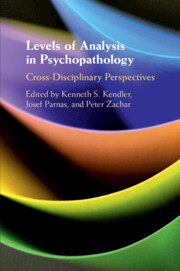Book contents
- Levels of Analysis in Psychopathology
- Advance Praise for Levels of Analysis in Psychopathology
- Levels of Analysis in Psychopathology
- Copyright page
- Contents
- Figures
- Tables
- Contributors
- Preface
- General Introduction
- Part I Neuroscience, Mechanisms, and RDoC
- Part II Phenomenology, Biological Psychology, and the Mind–Body Problem
- Part III Taxonomy, Integration, and Multiple Levels of Explanation
- Section 8
- Section 9
- Section 10
- 28 Introduction
- 29 Psychiatric Classification: An A-reductionist Perspective
- 30 Double Black Diamond
- Section 11
- Section 12
- Section 13
- Section 14
- Section 15
- Index
- References
30 - Double Black Diamond
from Section 10
Published online by Cambridge University Press: 02 April 2020
- Levels of Analysis in Psychopathology
- Advance Praise for Levels of Analysis in Psychopathology
- Levels of Analysis in Psychopathology
- Copyright page
- Contents
- Figures
- Tables
- Contributors
- Preface
- General Introduction
- Part I Neuroscience, Mechanisms, and RDoC
- Part II Phenomenology, Biological Psychology, and the Mind–Body Problem
- Part III Taxonomy, Integration, and Multiple Levels of Explanation
- Section 8
- Section 9
- Section 10
- 28 Introduction
- 29 Psychiatric Classification: An A-reductionist Perspective
- 30 Double Black Diamond
- Section 11
- Section 12
- Section 13
- Section 14
- Section 15
- Index
- References
Summary
In their understandable desire to avoid the rigidity of some classification schemes, Romeijn and van Loo describe an empirically driven system for classification that emphasizes black-box prediction over questions of reduction or realism. I note that belief in diagnostic entities seems to persist even in a theoretical domain that is a-reductionist, and wonder why. The problem, I note, is very similar to the one faced by MacCorqodale and Meehl more than fifty years ago, when they were trying to extract clinical psychology from the tight strictures of operationalism.MacCorquodale and Meehl’s “hypothetical constructs” are a-realist in the same sense that Romeijn and van Loo’s prediction models are a-reductionist.
Keywords
- Type
- Chapter
- Information
- Levels of Analysis in PsychopathologyCross-Disciplinary Perspectives, pp. 371 - 376Publisher: Cambridge University PressPrint publication year: 2020



